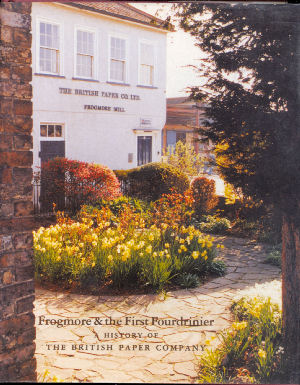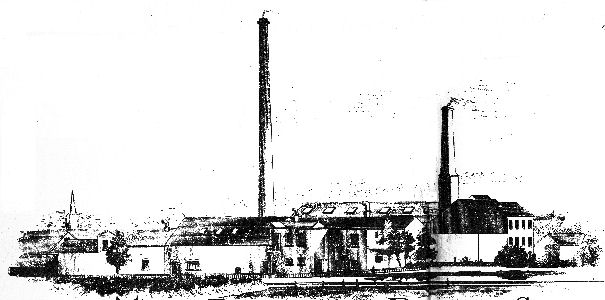 Frogmore and the First Fourdrinier
Frogmore and the First Fourdrinier
A History of the British Paper Company
Austin Pilkington
The British Paper Company, 1990
ISBN 0 9516646 0 3
The first machine for the manufacture of paper in a continuous web was set up at Frogmore, a small Hertfordshire village, in 1803. The inventor of the machine was a Frenchman, Nicolas Louis Robert, but it was financed by a firm of wholesale stationers, the Fourdriniers, who realised the enormous potential of the invention and developed it at great cost to themselves. From the Fourdriniers the Mill passed through various hands until it was acquired by Herbert Sanguinetti, the founder of The British Paper Company, which celebrates its Centenary this year.
Austin Pilkington describes the early days of papermaking at Frogmore Mill and goes on to trace the fortunes of its present owners. He tells of the various crises which the Mill has passed through up to the present day when it survives as one of the few independent papermakers in Britain, specialising in the use of recycled fibre, and small and flexible enough to provide a high quality of service to its customers.
Apart from the jacket, the book has been produced on recycled paper made at Frogmore Mill.
From the Dust Cover

Frogmore Mill in 1925 (from headed paper reproduced on the inside cover)
|
Contents
Appendices
|
Introduction
The Mill at Frogmore was a corn mill for five hundred years. The earliest record of papermaking on the site is contained in the Hemel Hempstead Rate Book where it is stated that in 1774 Edward Holmes was in occupation. In 1803 the lease was acquired by the Fourdriniers who installed the machine based on the model invented by Monsieur Louis Robert, which had been much improved by Mr. Bryan Donkin. A second machine, much larger, made by Donkin was installed in the following year and a third improved machine was started in 1805 at Two Waters Mill, a few hundred yards up the river Gade. This also was leased by the Fourdriniers.
When Frogmore Mill was purchased by The GrandJunction Canal Company in 1817 the 1804 Donkin machine was still being used. Various leaseholders including William Nash and John Dickinson & Co. occupied the Mill until The British Paper Company Limited was formed in 1890.
The link between Two Waters Mill and Frogmore Mill established by the Fourdriniers was not maintained continuously but was reestablished by G.W.Hayes when newsprint was made at both mills, and continued when Dickinsons leased Frogmore Mill and Two Waters Mill to prepare esparto half stuff and make it into paper. The Potosi Estate Company occupied Frogmore Mill when Dickinsons left in 1887, producing pulps from a variety of vegetable fibres including bamboo, esparto and wood.
In 1888 Herbert S. Sanguinetti formed the Universal Barrel Company to manufacture seamless barrels from paper at Two Waters Mill, and two years later in 1890 established The British Paper Company Limited at Frogmore Mill. Initially one machine produced paper and lightweight board for printers and laminators. In 1907 a second machine was installed under the direction of Cecil Sanguinetti, Herbert's third son, who largely controlled the destiny of the Mill until his death in 1962 in his 90th year. A third machine, the Rotiformer, was purchased soon after Roger Wallers became Chairman in the early sixties. These were unusually difficult times for the British economy and industry. Paper machines and mills were closing everywhere and by 1975 Frogmore was again a one machine Mill.
For most of the 100 years the Company made excellent profits and paid a very good return to the shareholders. For management the years of greatest struggle were the two World War periods and the sixties and seventies when industry was trying to cope with the inflationary effects of the first oil crisis, and was subjected to much Government intervention.
During this same period the directors were often preoccupied by the Shareholders Problem. The majority of the shares had been inherited and were held by ladies whose financial circumstances were deteriorating. They were also at an age when promises of future profits ran a very poor second to a return of capital. In 1979, after many other possible options had been considered by the directors, the eighty or so shareholders sold their interest to Quadrem Hope Limited, a Company formed by four members of the management team who obtained the backing of the National Westminster Bank.
Like many other traditional industries paper mills have been served by men and women of outstanding loyalty. Frogmore Mill is no exception, with sons and grandsons often following on. Although continuity of employment has mostly been secure, the rewards have seldom been equal to the dedication of their long working lives to processes which require discipline, hard physical effort and not a little skill.
The invention of Monsieur Louis Robert nearly 200 years ago, the engineering skill of Bryan Donkin and the enterprise and courage of the Fourdriniers and others established for the first time continuous papermaking by machine which led to the development of the world wide industry that we know today. This story together with that of The British Paper Company is told in celebration of one hundred years of this Company's existence.
| Locating
Books At the time this page was last updated second hand copies were available online |
| September2010 | Page Created | |

